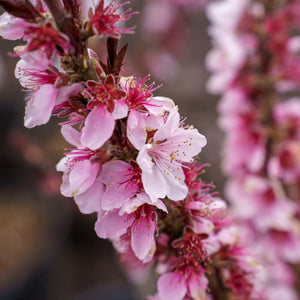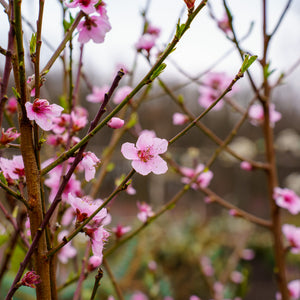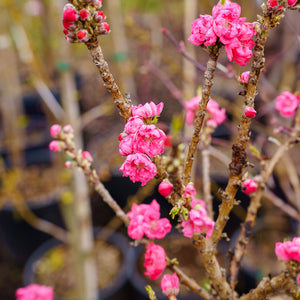The Peach Tree Guide
Peach trees (Prunus persica) are beloved fruit trees known for their fragrant spring blossoms, fast growth, and sweet, juicy fruit. Native to northwest China, they’ve become staples in home orchards, edible gardens, and backyard landscapes across temperate zones. Their compact size, manageable growth, and dual ornamental-edible value make them a rewarding choice for gardeners who want both beauty and bounty.

About
Prunus persica includes a wide variety of cultivars that produce yellow or white-fleshed fruit, either clingstone (where the flesh clings to the pit) or freestone (where the pit separates easily). Peaches are prized for their fuzzy skin, fragrant aroma, and sweet-tart flavor profile. The trees themselves are deciduous, with lance-shaped leaves and stunning pink to light rose-colored blossoms that appear in early spring before the foliage emerges.
Popular cultivars include:
- ‘Redhaven’ – A mid-season, freestone peach with excellent flavor and cold hardiness.
- ‘Contender’ – Late-blooming and cold hardy, ideal for northern climates.
- ‘Reliance’ – Known for reliable fruiting even after late spring frosts.
- ‘Belle of Georgia’ – A white-fleshed, freestone variety with large fruit and a vigorous growth habit.
- ‘White Lady’ – Low-acid, white peach with smooth texture and sweetness.
- ‘July Elberta’ – Early harvest with yellow fruit and rich flavor.
- ‘Loring’ – A flavorful, freestone variety with large fruit, excellent for fresh eating.
Peach trees bloom early and are typically self-pollinating, though planting multiple varieties can improve yields and fruit size. Their rapid growth and early fruiting—often within 2–4 years—make them a rewarding addition to any edible landscape.
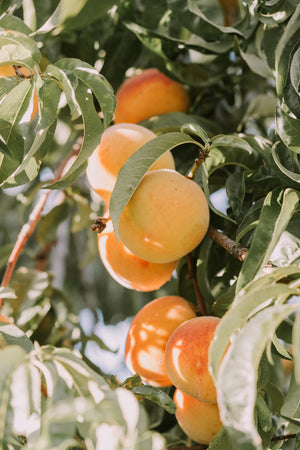
PLANTING
Peach trees require good sun, airflow, and soil drainage to thrive and produce fruit. Proper planting sets the stage for long-term success.
USDA Hardiness Zones: Generally suited for Zones 5–9. Some cold-hardy cultivars like ‘Contender’ can handle Zone 4 with protection.
Soil: Well-drained, loamy soil is ideal. Avoid clay-heavy or poorly draining areas, which increase risk of root rot.
Sunlight: Full sun (6–8 hours daily) is essential for fruit development and disease resistance.
Watering: Keep soil evenly moist during establishment. Once established, peaches need about 1 inch of water per week, especially during fruit development.
Spacing: Standard varieties should be spaced 15–20 feet apart. Dwarf trees can be spaced as close as 8–10 feet.
Planting Time: Early spring is best in northern climates. In warmer areas, fall planting is also suitable.
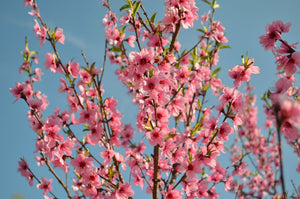
CARE
Watering: Water newly planted peach trees deeply once or twice a week. Mature trees need consistent moisture from bloom to harvest. Avoid overwatering, which can lead to disease.
Fertilizing: Apply a balanced fertilizer (10-10-10) in early spring before new growth begins. Avoid over-fertilizing, which can reduce fruit production and increase pest issues.
Pruning: Prune annually in late winter while the tree is dormant. Remove dead or crossing branches, and open the center of the tree to light and airflow using an open vase shape. Regular pruning is essential for fruit quality and disease prevention.
Pests and Diseases: Common issues include peach leaf curl, brown rot, and plum curculio. Use dormant oil sprays in late winter and consider fungicides or organic treatments as needed. Maintain clean ground beneath the tree.
Mulching: Apply mulch 2–3 inches deep to conserve moisture and suppress weeds. Keep mulch 2–4 inches away from the trunk.
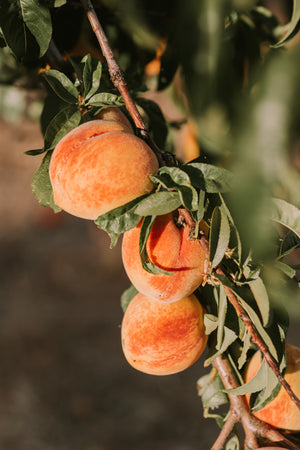
HOW TO USE
Focal Point: A peach tree in full bloom is a showstopper. Use it as a spring focal point in edible landscapes or front yard orchards. The combination of flowers, foliage, and fruit adds multi-season interest.
Edible Landscapes: Peach trees are essential in home orchards. Combine with plums, apples, and pears for a full fruiting garden. Underplant with herbs like thyme or chives to deter pests and attract pollinators.
Container Gardening: Dwarf peach varieties can be grown in large containers on patios or balconies. Choose self-pollinating cultivars and ensure regular feeding and watering.
Pollinator Gardens: Peach blossoms attract early-season pollinators. Pair with spring-blooming bulbs or native wildflowers to extend nectar sources throughout the season.
Cottage Gardens: Blend peaches with ornamental shrubs like hydrangea or flowering quince. Their blooms and structure align well with informal, flower-rich designs.
Espalier or Fan Training: In small spaces, train peaches against a wall or fence. This saves space, improves airflow, and makes harvesting easier.
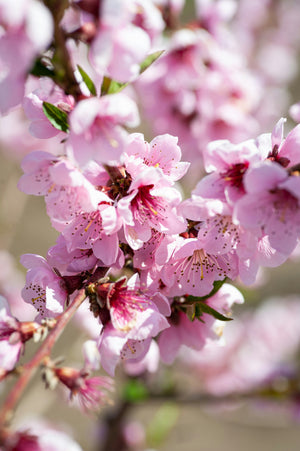
Common Questions
How to grow a peach tree? Choose a sunny, well-drained site. Plant in early spring, water regularly, and prune to create a strong structure. Provide protection from pests and late frosts.
How to prune a peach tree? Use an open-center or vase shape. Remove interior branches to let in light. Always prune in late winter when the tree is dormant.
How to plant a peach tree? Dig a hole twice as wide as the root ball. Plant at the same depth it was growing in the nursery container. Backfill with native soil, water deeply, and mulch.
How big do peach trees get? Standard trees grow 15–25 feet tall and wide. Dwarf forms reach 6–10 feet.
How fast do peach trees grow? Peaches grow quickly, often producing fruit within 2–4 years after planting.
How long does it take for a peach tree to produce fruit? Most peach trees produce their first crop within 2–4 years.
When do peach trees bloom? Peaches bloom early in spring, usually before leaves appear. Bloom time varies by climate and variety.
Are peach trees self-pollinating? Yes, most are self-pollinating, though planting more than one variety can improve yields.
How long do peach trees live? Peach trees typically live 12–20 years, with peak fruiting between years 4 and 12.
How often should I water newly planted peach trees? Water once or twice a week during dry periods for the first year. Deep watering encourages strong root development.
Conclusion
Peach trees bring beauty, flavor, and structure to edible and ornamental gardens. With the right care—sun, pruning, and proper siting—you’ll enjoy years of fragrant spring blooms and sweet summer harvests. Whether planted as a backyard staple, in containers, or as part of a home orchard, peaches offer an unbeatable combination of aesthetic charm and garden productivity.
The Peach Collection
Sold Out
Sold Out
Sold Out
Sold Out
Sold Out

